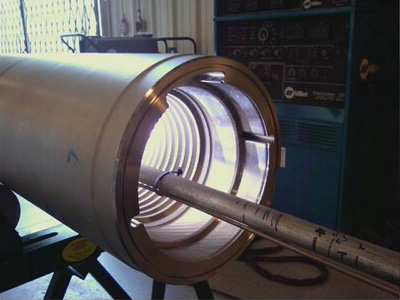Cladding welding
Ir a Explosive welding – In explosive welding , the pressure to bond the two layers is provided by detonation of a sheet of chemical explosive. No heat-affected zone is produced in the bond between metals. The explosion propagates across the sheet, which tends to expel impurities and oxides from between the . Generally this is used for corrosion resistance or wear resistance and frequently a different material is used for the clad than for the base metal. Weld cladding is typically between and about mm thick.
Design considerations and the welding of stain- less-steel- clad carbon and low-alloy steels are also addressed.

Additional information can be found in Ref to 3. Hot Roll Bonding (Ref 3). The hot roll bonding process, which is . Weld overlay cladding by Arc Energy Resources Ltd. Weld Overlay (WOL), also known as cladding , hardfacing, weld cladding , or weld overlay cladding , is a process where one or more metals are joined together via welding to the surface of a base metal as a layer.
This is normally done to improve the material by adding either a corrosion resistant or hardfacing layer to it. Typical components clad by Arc Energy include pipes, valves, flanges, . It can be applied to an entire component, or only to specific areas of concern.

Cladding with TIG and TIGer process. Westermans supply used welding and cutting equipment to these Industry sector. Thank you for A2A Answer cladding : Clad plate can be formed and fabricated using conventional techniques. To increases the durability of these highly exposed parts, their surfaces are protected by a welding overlay with more resistant materials.
The steel is welded using ordinary welding materials and practices. The clad material is welded using high alloy filler metal. Conforma Clad and UltraFlex, and hardfaced components.
Hardfacing materials We have hardfacing products for: Oxy-acetylene welding Metal Inert Gas (MIG) welding Tungsten Inert Gas (TIG) welding Plasma. Welder , Senior Quality Assurance Inspector, Senior Application Engineer and more! Clad welding is the process of adding a material to the surface of a component, rather than joining it to another piece. This is helpful in changing the design of, adding a protective layer to, or repairing an existing component.
Its popularity has risen due to the cost-effectiveness of the process. And with the high quality laser. Abstract In weld cladding the opposing nature of deposition rate and dilution, owing to the inherent nature of the welding arc, affects the quality and economy of a cladding operation directly, which makes it difficult to arrive at a correct . Welding RD at the Nuclear AMRC focuses on developing advanced and innovative joining and cladding techniques tailored to the needs of the nuclear industry. Many key components in a nuclear power plant must be manufactured by joining very large sub-components in a way that resists corrosion and maintains .